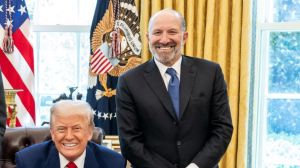Indian, Chinese soldiers engage in Tawang face-off; ‘minor injuries’ to both sides
The incident came days after China expressed objection to Operation Yudhabhyas, an India-US joint military exercise at Auli in the Uttarakhand hills, claiming it was a violation of 1993 and 1996 border agreements.
 Sources said both sides immediately disengaged from the area. (Representational/ AP file)
Sources said both sides immediately disengaged from the area. (Representational/ AP file) Indian and Chinese troops clashed in Arunachal Pradesh’s Tawang sector in the early hours of December 9, beating each other up with sticks and canes in their closest encounter since the deadly Galwan incident in eastern Ladakh in June 2020.
The Indian soldiers who were injured in the clash are recuperating in a Guwahati hospital, sources said.
The “face-off led to minor injuries to few personnel from both sides,” an Army officer said. “Both sides immediately disengaged from the area. As a follow up of the incident, own (Indian) commander in the area held a flag meeting with his counterpart to discuss the issue in accordance with structured mechanisms to restore peace and tranquility,” the officer said.
The incident came days after China expressed objection to Operation Yudhabhyas, an India-US joint military exercise at Auli in the Uttarakhand hills, claiming it was a violation of 1993 and 1996 border agreements.
The continuing military tensions at different points along the 3,000 km-Line of Actual Control comes as New Delhi kicked off a series of events as part of its presidency of the G-20, a grouping of the world’s leading economies that includes China.
Incidentally, Prime Minister Narendra Modi and President Xi Jinping met at the G-20 summit in Bali in November and exchanged courtesies but did not hold any substantive talks or discussions.
 Indian and US Army personnel during the joint exercise in Auli, Uttarakhand. (PTI/File)
Indian and US Army personnel during the joint exercise in Auli, Uttarakhand. (PTI/File)
The clash in Arunachal Pradesh took place at about 3 am last Friday at a nullah along the LAC in the Tawang heights near a point called Yangtse in Eastern Tawang. This part of the LAC is one of the “agreed disputed areas” between the two sides, according to military sources.
New front
The clash in Tawang in the LAC's eastern sector, that includes Sikkim and Arunachal Pradesh, comes when tensions in the northern sector of Ladakh are yet to be fully resolved.
Indian and Chinese troops are positioned on either side of the nullah, but on this night, some 300 Chinese troops came into the Indian side.
There were no warning signs about the transgression and hearing the sentries being assaulted, some 70 to 80 Indian troops mobilised quickly in the dead of night to push back the intruders. There was intense hand-to-hand combat with sticks and canes for a few hours, according to sources.
The clash was “more than pushing and shoving”, the sources said, although it was not clear if there were any serious injuries on either side.
“PLA troops contacted the LAC in Tawang Sector which was contested by our troops in a firm and resolute manner. This face-off led to minor injuries to a few personnel from both sides,” a military source said.
Both sides “immediately” disengaged from the area, according to the source, who also said that afterward, “our Commander in the area held a Flag Meeting with his counterpart to discuss the issue in accordance with structured mechanisms to restore peace and tranquillity”.
“In certain areas along the LAC in the Tawang Sector in Arunachal Pradesh there are areas of differing perception, where both sides patrol the area up to their claim lines. This has been the trend since 2006,” the military source said.
A similar transgression had taken place in June 2016 when around 250 PLA soldiers had transgressed into the area but no clashes were reported then. A military officer who has served in the area said there was no predicting when the PLA would carry out such operations as “the Chinese perpetually control the escalatory ladder in that area” and they do so “at a place of their choosing”.
A top source in the government told The Indian Express that this time the PLA had “pre-planned” the transgression for an “opportune” time. The location of the skirmish is described as heavily forested terrain, with Chinese troops occupying “top of the wall” positions with deep supply lines and infrastructure.
Due to snowfall in the area, this was also the time for some Indian troops to withdraw from their positions, giving the Chinese side a further tactical upper hand, said the source. A heavy cloud cover also made it challenging for Indian satellites to capture images of any troop build-up.
After the clash, the Indian side is said to have used Radio Frequency (RF) signal geolocation equipment to reconstruct satellite images. The high-resolution satellite imagery is presently being analysed by the Indian military and security establishment.
The incident has put troops in the area on heightened alert. Just three months ago, in September, Indian and Chinese troops disengaged in the Gogra Hotspring area of Eastern Ladakh, the last of the acknowledged “friction points” that were discussed over 16 rounds of military commander level talks that began in May 2020, after Chinese incursions at several points in the area.
The Galwan incident, which claimed the lives of 20 Indian soldiers, came after the two sides had discussed disengagement in the area.
Tensions in Ladakh continue over the build-up of Chinese troops in Depsang, intrusions in Demchok and the rapid infrastructure build up by the Chinese, including two bridges over the Pangong lake that will reduce Chinese mobilisation time on the southern bank.
Speaking recently on India-China relations, External Affairs Minister S Jaishankar recently said that “unless there is peace and tranquillity in the border areas… unless there is an observance of agreements and no unilateral attempt to change status quo… the situation cannot be, and is not, normal”.







